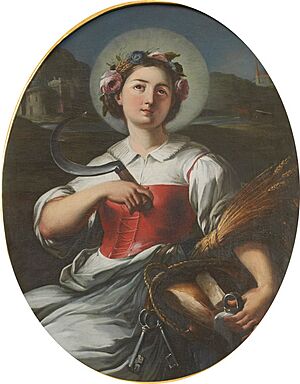Notburga facts for kids
Quick facts for kids SaintNotburga of Rattenberg |
|
|---|---|

The Baroque painting of Saint Notburga in the church on Bled Island, northwestern Slovenia
|
|
| Virgin and Peasant | |
| Born | c. 1265 Rattenberg, Austria |
| Died | September 13, 1313 (aged 47–48) Buch, Austria |
| Venerated in | Catholic Church |
| Canonized | 27 March 1862, Saint Peter's Basilica, Papal State by Pope Pius IX |
| Major shrine | Shrine of Saint Notburga, Chapel of Saint Rupert, Eben, Austria |
| Feast | 13 September |
| Attributes | Ear of corn, or flowers and a sickle in her hand; sometimes the sickle is suspended in the air |
| Patronage | Rural Youth Servants Peasants |
Notburga (born around 1265, died September 13, 1313) was a special woman from Austria. She was a simple peasant who became known as a saint. People also call her Notburga of Rattenberg or Notburga of Eben. Many stories and paintings show her with a scythe, a tool used for cutting grass. The Catholic Church honors her, and she was officially made a saint by Pope Pius IX.
Contents
The Life of Saint Notburga
Notburga was born around the year 1265 in a town called Rattenberg, near the Inn river. She worked as a cook for a rich family, the household of Count Henry of Rattenberg. Notburga was very kind and often gave leftover food to people who were poor.
However, the Count's wife, Ottilia, did not like this. She told Notburga to give all the leftover food to the pigs instead. But Notburga really wanted to help the poor. So, she started saving some of her own food, especially on Fridays. She would then secretly take this food to those in need.
Miracles and Challenges
One day, the Count saw Notburga carrying something. He asked her to show him what she had. When she opened her apron, the food she was carrying had changed. Instead of food, he saw only wood shavings. And the wine she had was now just vinegar.
Because of this, Ottilia fired Notburga from her job. Soon after, Ottilia became very sick. Notburga, being a kind person, stayed to take care of her. She helped Ottilia prepare for her death.
After leaving the Count's house, Notburga found a new job. She worked for a farmer in a place called Eben am Achensee. She had one important condition for her new job. She wanted to be allowed to go to church every evening before Sundays and other special holidays.
One evening, her new master wanted her to keep working in the field. He told her not to go to church. Notburga then threw her sickle into the air. She supposedly said, "Let my sickle be the judge between us." The story says the sickle stayed floating in the air.
Return and Final Resting Place
Meanwhile, Count Henry, her first master, started having problems. He believed these troubles happened because he had fired Notburga. So, he asked her to come back and work for him again. When Notburga returned, his estate began to do well once more.
Just before she died, Notburga told her master something special. She asked him to place her body on a wagon pulled by two oxen. She wanted to be buried wherever the oxen stopped on their own. The oxen pulled the wagon all the way to a small church, the chapel of St. Rupert, near Eben. That is where she was buried.
Honoring Saint Notburga
On March 27, 1862, Pope Pius IX officially recognized Notburga as a saint. This process is called Canonization. Her special day, or feast day, is celebrated every year on September 13.
When you see pictures or statues of Saint Notburga, she is often shown with certain items. She might have an ear of corn, or flowers, and a sickle in her hand. Sometimes, the sickle is even shown floating in the air, remembering the miracle from her life story.

